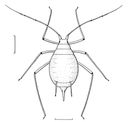Pea Aphid
Acyrthosiphon pisum
Classification
- Phylum: Arthropoda
- Subphylum: Hexapoda
- Class: Insecta
- Order: Hemiptera
- Suborder: Sternorrhyncha
- Superfamily: Aphidoidea
- Family: Aphididae
- Subfamily: Aphidinae
- Tribe: Macrosiphini
- Genus: Acyrthosiphon
- Species: pisum
Pronunciation
How to pronounce Acyrthosiphon pisum: /əˌsɜːrθəˈsɪfɒn ˈpaɪsəm/
These audio files are automatically generated. While they are not always 100% accurate, they are a good starting point.
Images






Summary
Acyrthosiphon pisum, or the pea aphid, is an agriculturally significant pest of legumes known for its rapid reproductive cycle and complex interactions with symbiotic bacteria, making it an important model organism in biological studies.
Physical Characteristics
Acyrthosiphon pisum is a relatively large aphid, with adults typically reaching up to 4 millimeters in length. They exhibit color variations including green and red/pink morphs, with green morphs being more common in natural populations.
Identification Tips
Pea aphids can be recognized by their size, color variations, and the presence of winged and wingless individuals. They feed predominantly on the lower sides of leaves, buds, and pods of legumes.
Habitat
Acyrthosiphon pisum primarily inhabits areas with legume crops, such as fields and gardens where forage crops grow, particularly in temperate climates.
Distribution
Originally from the Palearctic region, Acyrthosiphon pisum is now commonly found worldwide, particularly in agricultural regions of North America where it has spread significantly since its introduction in the 1870s.
Diet
The pea aphid feeds on phloem sap from various legume species, including pea (Pisum sativa), alfalfa (Medicago sativa), clover (Trifolium pretense), and broad bean (Vicia faba).
Life Cycle
Pea aphids undergo a cycle where fertilized eggs overwinter, hatching in spring. The nymphs develop into adults within 7-10 days, with parthenogenetic reproduction leading to multiple generations of females throughout the warmer months before producing sexual individuals in autumn.
Reproduction
Reproduction in Acyrthosiphon pisum typically occurs through viviparous parthenogenesis, with females producing 4 to 12 female nymphs daily, resulting in approximately 100 offspring in their lifetime. Some sexual reproduction occurs later in the year when conditions change.
Predators
Natural predators of the pea aphid include parasitoid wasps and other insectivorous species, which can help control aphid populations in agricultural settings.
Ecosystem Role
As a sap-sucking herbivore, the pea aphid plays a significant role in the dynamics of its ecosystem, impacting plant health and serving as a food source for predators.
Economic Impact
Acyrthosiphon pisum is a major pest on legumes and contributes to hundreds of millions of dollars in crop damage annually due to its feeding habits and as a vector for viral diseases.
Collecting Methods
- Hand collection from host plants
- Sticky traps to capture winged forms
Preservation Methods
- Ethanol preservation
- Freezing for morphological studies
Evolution
Acyrthosiphon pisum has evolved through a mutualistic relationship with Buchnera aphidicola, an endosymbiotic bacterium that provides essential amino acids not available from its plant diet. This relationship likely evolved over 160-280 million years ago.
Misconceptions
Some may believe that all aphids have complex colony structures; however, pea aphids do not form dense colonies and can have winged individuals that migrate to new host plants.
Tags
- Aphid
- Pea Aphid
- Agricultural Pest
- Sap-Sucking Insect